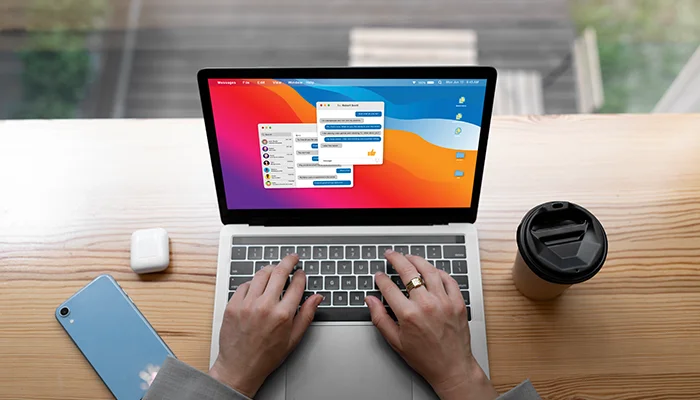6 Best Image Formats to Use for Site Design and Development

MAY, 9, 2024 14:40 PM
6 Best Image Formats to Use for Site Design and Development
In the realm of site design and development, images play a pivotal role in enhancing the user experience, conveying information, and beautifying the overall aesthetic. However, selecting the right image format is crucial to ensuring optimal performance, compatibility, and visual appeal. In this comprehensive guide, we'll delve into the six best image formats tailored for site design and development, empowering you to make informed choices that elevate your web presence. Whether you're a web design and development company in the USA or a solo designer, mastering these image formats is essential for creating stunning websites.
JPEG (Joint Photographic Experts Group)
JPEG stands tall as one of the most widely used image formats on the web, and for good reason. Its efficient compression algorithm strikes a balance between image quality and file size, making it ideal for photographs and complex images. In site design and development, JPEGs are invaluable for showcasing high-resolution visuals without sacrificing loading speed. From vibrant product images to captivating banners, JPEGs seamlessly integrate into diverse web environments, captivating audiences with their crispness and clarity.
Pros:
- High compression ratio: JPEG compression significantly reduces file sizes without substantial loss of quality, facilitating faster page loading times.
- Wide compatibility: supported by all major web browsers and platforms, ensuring seamless integration into web designs.
Cons:
- Lossy compression: Repeated compression and decompression of JPEG images can lead to noticeable degradation in quality, impacting image fidelity.
- Not suitable for transparent images: JPEG does not support transparency, making it unsuitable for images requiring transparent backgrounds.
PNG (Portable Network Graphics)
When it comes to preserving image quality with transparency, PNG emerges as the go-to choice for web designers and developers. Unlike JPEG, PNG supports lossless compression, making it perfect for graphics, logos, and illustrations where every pixel matters. Web design and development companies in the USA leverage PNGs to achieve seamless integration with diverse website elements, from navigation bars to social media icons. Moreover, the ability to maintain transparency adds versatility to PNGs, allowing designers to overlay images onto different backgrounds without compromising visual integrity.
Pros:
- Lossless compression: PNG employs lossless compression, preserving image quality without sacrificing detail or clarity.
- Transparency support: PNG supports alpha transparency, allowing for seamless integration of images with any background color or pattern.
Cons:
- Larger file sizes: Compared to JPEG, PNG files tend to be larger, which can impact page loading times, especially for websites with multiple high-resolution images.
- Limited support for photographs: While PNG is suitable for graphics, it may not be the most efficient choice for photographs or images with complex gradients.
SVG (Scalable Vector Graphics)
In the era of responsive web design and development, scalability reigns supreme, and SVG emerges as the undisputed champion in this domain. Unlike raster-based formats like JPEG and PNG, SVG relies on vectors, enabling images to scale infinitely without losing quality. This makes SVG indispensable for designing responsive websites that adapt seamlessly to various screen sizes and resolutions. Web design and development companies in the USA harness the power of SVGs to create dynamic visuals, ranging from animated icons to interactive graphics. Furthermore, SVGs offer the added advantage of smaller file sizes compared to their raster counterparts, contributing to faster loading times and enhanced user experiences.
Pros:
- Scalability: SVG images are resolution-independent and can be scaled to any size without loss of quality, ensuring crisp and clear rendering on devices with varying screen resolutions.
- Small file sizes: SVG files are typically smaller in size compared to raster formats like JPEG or PNG, contributing to faster page loading times.
Cons:
- Complexity for complex images: While ideal for simple graphics and icons, SVG may encounter performance issues with highly complex images or illustrations.
- Browser compatibility: While most modern browsers support SVG, older versions may encounter compatibility issues, requiring fallback options for broader compatibility.
GIF (Graphics Interchange Format)
Although GIFs have been around for decades, their charm and versatility remain unrivalled in the realm of web design and development. Loved for their ability to convey motion and emotion in a compact package, GIFs add a dash of dynamism to websites, capturing users' attention and fostering engagement. From quirky animations to informative tutorials, GIFs serve as invaluable assets for conveying complex ideas in a digestible format. Web design and development companies in the USA leverage GIFs to inject personality into brands, creating memorable user experiences that leave a lasting impression.
Pros:
- Animation support: GIF allows for the creation of simple animations and looping sequences, making it ideal for displaying dynamic content such as banners or icons.
- Transparency support: GIF supports basic transparency, enabling the creation of images with transparent backgrounds.
Cons:
- Limited color palette: GIF is limited to a maximum of 256 colors, which may result in reduced image quality, especially for photographs or images with complex color schemes.
- Large file sizes: Animated GIFs, in particular, can result in large file sizes, impacting page loading times and the user experience.
WebP
As the demand for faster, more efficient websites continues to rise, WebP emerges as a game-changer in the realm of image formats. Developed by Google, WebP combines the best of JPEG and PNG, offering superior compression efficiency without compromising image quality. With smaller file sizes compared to traditional formats, WebP accelerates website loading times, delivering a smoother browsing experience for users. Web design and development companies in the USA embrace WebP to optimize website performance without sacrificing visual fidelity, ensuring that every image pops with clarity and detail. Although support for WebP is still evolving, its widespread adoption by major browsers signals a shift towards a more efficient web ecosystem, where speed and quality go hand in hand.
Pros:
- High compression efficiency: WebP utilizes advanced compression algorithms to achieve smaller file sizes without significant loss of image quality, enhancing page loading times and the user experience.
- Support for transparency: WebP supports both lossy and lossless compression modes, enabling transparency while maintaining image quality.
Cons:
- Limited adoption: Despite its advantages, WebP adoption among web developers and designers remains relatively low compared to established formats like JPEG and PNG.
- Compatibility with older browsers: Older versions of web browsers, particularly Internet Explorer, may not support WebP without additional fallback options, necessitating consideration of broader compatibility.
JPEG 2000

While JPEG reigns supreme in the realm of web images, JPEG 2000 emerges as its sophisticated cousin, offering enhanced features and capabilities. Leveraging advanced compression algorithms, JPEG 2000 delivers superior image quality at smaller file sizes, making it an attractive option for high-resolution photographs and graphics. With support for lossless compression and transparency, JPEG 2000 pushes the boundaries of image optimization, catering to the evolving demands of modern web design and development. Web design and development companies in the USA looking to elevate their visual storytelling leverage JPEG 2000 to showcase products, portfolios, and multimedia content with unparalleled clarity and depth. Although broader support for JPEG 2000 is still pending, its potential to revolutionize web imaging makes it a format worth exploring for forward-thinking designers and developers.
Pros:
- Superior image quality: JPEG 2000 utilizes wavelet compression to achieve higher image quality compared to traditional JPEG, particularly for photographs and images with fine details.
- Lossless compression option: JPEG 2000 supports both lossy and lossless compression modes, providing flexibility for different use cases and quality requirements.
Cons:
- Limited browser support: Despite its technical advantages, JPEG 2000 adoption remains limited due to inconsistent support across web browsers and platforms.
- Larger file sizes: While JPEG 2000 offers superior image quality, its files tend to be larger compared to formats like JPEG and WebP, potentially impacting page loading times.
Conclusion
In the dynamic world of website design and development, choosing the right image format is paramount to creating visually stunning and high-performing websites. Whether you're a seasoned web design and development company in the USA or an aspiring designer, mastering the nuances of JPEG, PNG, SVG, GIF, WebP, and JPEG 2000 unlocks a world of creative possibilities. By understanding the strengths and applications of each format, designers and developers can craft immersive web experiences that captivate audiences, foster engagement, and elevate brands to new heights of success. Embrace the power of image formats and watch your web site design and development endeavors flourish in the digital landscape.
FAQS
Q1. What factors should I consider when choosing an image format for my website's design and development?
A1. When selecting an image format, consider factors such as the type of content (photographs, graphics, animations), desired image quality, need for transparency, page loading times, and browser compatibility. Assessing these aspects will help you determine the most suitable format for your specific requirements.
Q2. How does image compression impact website performance, and which formats offer the best balance between file size and image quality?
A2. Image compression plays a crucial role in website performance by reducing file sizes without significant loss of quality. Formats like JPEG and WebP excel in compression efficiency, offering smaller file sizes while maintaining acceptable image quality. However, it's essential to strike a balance between compression and image fidelity based on your site's needs.
Q3. Can I use multiple image formats within the same website, and are there any best practices for doing so?
A3. Yes, you can use multiple image formats within the same website to optimize performance and accommodate different types of content. For instance, you might use JPEG for photographs, PNG for graphics requiring transparency, and SVG for scalable icons. Best practices include optimizing images for the web, leveraging responsive design techniques, and implementing appropriate fallbacks for broader compatibility.
Strategy
Design
Blockchain Solution
Development
Launching
Testing
Maintenance
Contact US!
India

Plot 378-379, Udyog Vihar Phase 4 Rd, near nokia building, Electronic City, Phase IV, Sector 19, Gurugram, Haryana 122015
Copyright © 2025 PerfectionGeeks Technologies | All Rights Reserved | Policy
Strategy
Design
Blockchain Solution
Development
Contact US!
India 
Plot 378-379, Udyog Vihar Phase 4 Rd, near nokia building, Electronic City, Phase IV, Sector 19, Gurugram, Haryana 122015
USA 
1968 S. Coast Hwy, Laguna Beach, CA 92651, United States
Copyright © 2025 PerfectionGeeks Technologies | All Rights Reserved | Policy




